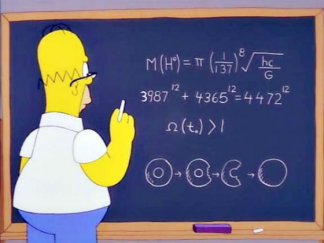A new book investigating the maths in The Simpsons has revealed something ridiculously awesome and completely unexpected - in the 1998 episode "The Wizard of Evergreen Terrace", Homer comes up with a mathematical equation that predicts the mass of the Higgs boson more than a decade before physicists at CERN discovered it.
Why, you ask? Well if you don't remember the episode, Homer suddenly becomes an inventor, coming up with such devices as an electric hammer and a make-up gun. In the process, he unleashes his hidden mathematical ability, predicting the mass of the Higgs boson to be 775 giga-electron-volts (GeV). British science writer and author of The Simpsons and their Mathematical Secrets, Simon Singh, says in the scheme of things, that figure isn't actually that far off the 125 GeV estimate that was the result of the CERN Higgs boson discovery in 2012.
"If you work it out, you get the mass of a Higgs boson that's only a bit larger than the nano-mass of [what] a Higgs boson actually is," Singh told Nick Clark at The Independent. "It's kind of amazing as Homer makes this prediction 14 years before it was discovered."
Turns out a lot of the writers on The Simpsons are mathematicians, Singh telling The Independent that it's "the most mathematical TV show on prime-time television in history." The mathematician who happened to write that formula for Homer is David X. Cohen, who went on to be the head writer and executive producer of Futurama. According to Richard Gray at The Daily Mail, Cohen contacted one of his high school friends, David Schiminovich, who is an astronomer at Columbia University, and worked with him on the equation.
"The equation is a playful combination of various fundamental parameters, namely the Planck constant, the gravitational constant, and the speed of light," Singh told him.
The Simpsons has ended up being a real treasure trove of fascinating little tidbits for scientists to mull over. Just last month, astronomer Phil Plait made the rather unsettling discovery that Springfield might just be set in the Southern Hemisphere, thanks to THIS MOON. And late last year, the most mathematical show on prime-time television, plus someone called 'Kim Jong Fun', helped prove the very important point that some journals will publish literally anything. How lucky are we to have had Homer and co. in our lives for almost 30 years?
Source: The Independent
